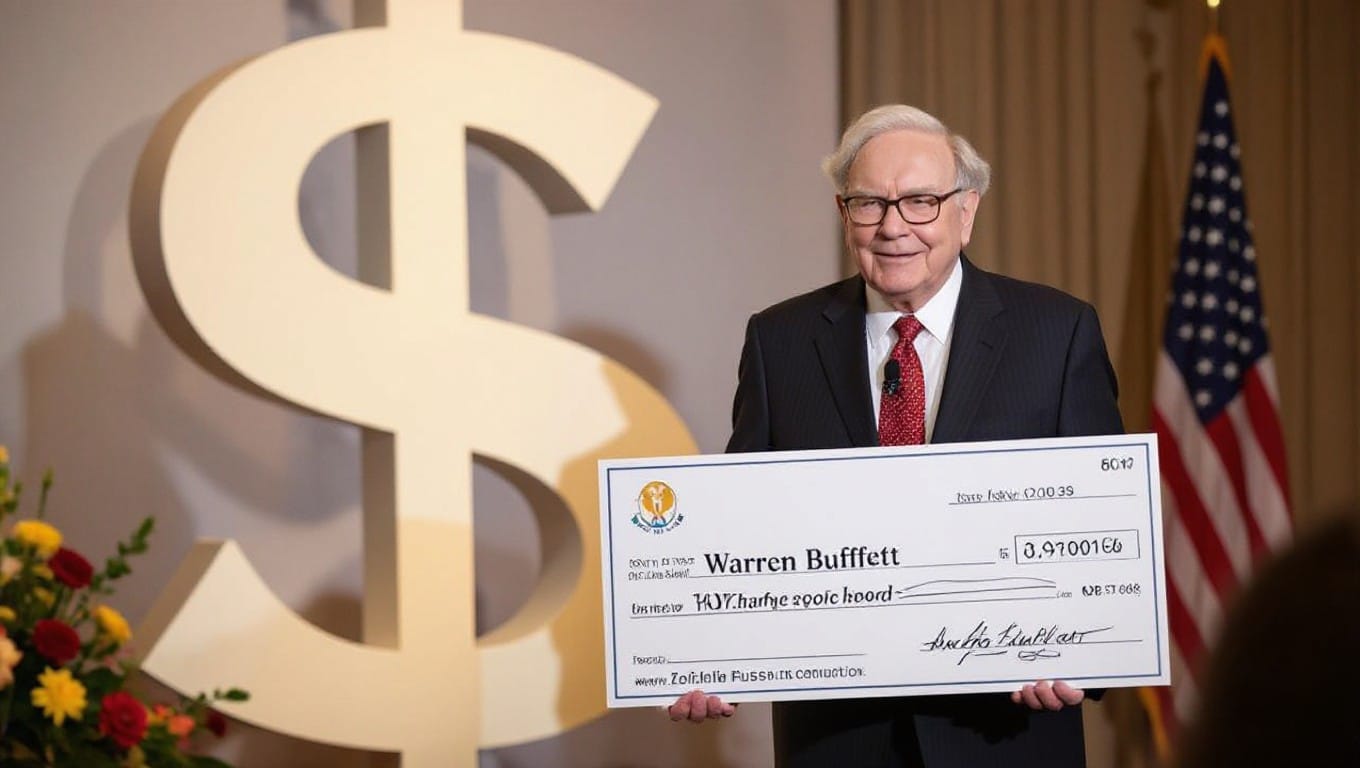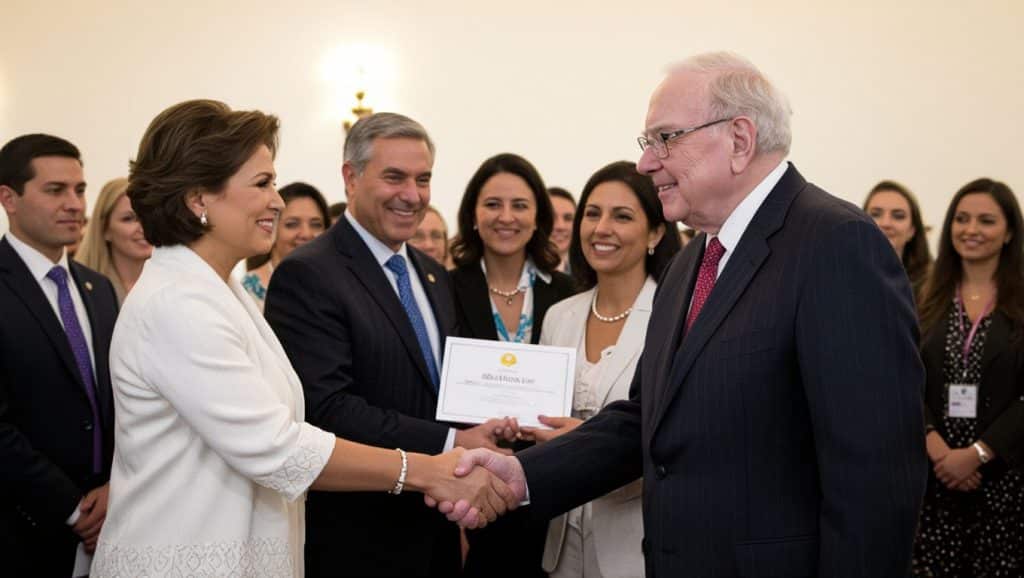Record-Breaking Philanthropy: Buffett’s Latest Donation
Warren Buffett’s $6 billion gift in Berkshire Hathaway shares marks his largest single-year donation since he began giving away his fortune nearly two decades ago. By transferring about 12.36 million Class B shares, he has pushed his total charitable contributions to over $60 billion. The bulk of this latest gift—9.43 million shares—went directly to the Gates Foundation, reaffirming Buffett’s commitment to collaboration with one of the world’s most influential philanthropic organizations. The remainder was distributed among family-led foundations addressing a wide range of causes, from reproductive health to fighting hunger and supporting marginalized communities.
This donation also reflects an ongoing strategic approach: Buffett has consistently increased his giving over recent years. Last June, he donated $5.3 billion in stock, and in November, another $1.14 billion went to family charities. Despite these large transfers, Buffett continues to hold a substantial 13.8% stake in Berkshire Hathaway, signaling that his philanthropy coexists with continued confidence in the company’s future. His kids now oversee nearly all remaining funds through a trust, with unified authority to decide how best to deploy this immense philanthropic capital over the coming decade.
The Mechanics of the Gift
Warren Buffett’s latest donation involved transferring approximately 12.36 million Berkshire Hathaway Class B shares, a move that requires careful coordination between legal, tax, and brokerage entities to ensure a smooth transition of assets. These shares represent a significant portion of his annual philanthropic activity, executed under long-standing frameworks that have governed his giving since 2006. The process typically involves directly moving stock certificates or using electronic share transfer systems to deliver the shares into the custody of the designated foundations, allowing them immediate access to potentially liquidate or hold the equity as their endowments dictate.

Breakdown of Shares Distributed
The distribution of shares from Buffett’s donation shows a clear pattern of supporting both long-standing and diverse philanthropic causes. The Gates Foundation received the lion’s share with 9.43 million shares, reflecting its role as the primary beneficiary of Buffett’s largesse over the years. The next allocation went to the Susan Thompson Buffett Foundation, with 943,384 shares, emphasizing reproductive health initiatives and reflecting Susan Buffett’s enduring philanthropic legacy.
Each of the three family-led foundations—Howard G. Buffett Foundation, Sherwood Foundation, and NoVo Foundation—received 660,366 shares apiece. This distribution aligns with their individual missions, spanning global hunger, early childhood education, human trafficking combat, and support for marginalized communities. The precise allotment signifies Buffett’s intention to maintain a balanced philanthropic approach, empowering his children’s foundation leadership while addressing a broad spectrum of societal challenges.
Impact on Berkshire Hathaway’s Stock Ownership
After this sizable donation, Buffett remains a significant shareholder, holding onto 13.8% of Berkshire Hathaway’s outstanding stock. While transferring over 12 million shares might seem substantial, you’ll notice it represents only a modest shift in his total ownership percentage. This careful maintenance of his stake highlights an ongoing strategy to retain control and influence over Berkshire’s long-term direction, even as he systematically reduces his personal holdings through charitable gifts.
For investors and market watchers, this steady dilution through philanthropy signals Buffett’s confidence in the consolidated value of his holdings and the resilience of Berkshire Hathaway’s business model. Maintaining close to a 14% ownership also ensures his voting power remains intact, a factor critical to overseeing the conglomerate’s management and strategic decisions.
Buffett’s reluctance to sell any shares, despite the volume donated, reinforces the notion that he views these gifts as the primary method for asset transfer rather than market sales which could influence share prices. It further reflects a sophisticated balance of philanthropy, financial prudence, and shareholder stewardship that has defined Buffett’s approach for decades.
Generational Transfer of Wealth
Warren Buffett’s approach to wealth transfer extends beyond simple inheritance, structuring his giving to ensure sustained impact across generations. With 99.5% of his remaining fortune designated for a charitable trust managed by his children, you can see a deliberate strategy that balances preservation of capital with targeted philanthropy. The trust provides his heirs about a decade to distribute the funds, requiring unanimous decisions, which imposes a structured collaborative governance model to maintain Buffett’s vision after his passing.
This generational framework not only helps avoid potential fragmentation of the fortune but also empowers his children—Susie, Howard, and Peter—to guide philanthropy through their own expertise while aligning with their father’s principles. As the trust begins operations, it will be interesting to observe how their stewardship shapes future allocations, potentially adapting to evolving social priorities while maintaining substantial, long-term funding.
The Buffett Family’s Charitable Foundations
The various foundations led by Buffett’s children reflect diverse yet complementary philanthropic focuses. Susie Buffett’s leadership of the Susan Thompson Buffett Foundation emphasizes reproductive health, honoring her mother’s legacy. Howard’s foundation prioritizes global hunger, anti-human trafficking efforts, and conflict mitigation, displaying a strong commitment to solving fundamental humanitarian challenges. Meanwhile, the Sherwood Foundation concentrates on bolstering Nebraska nonprofits and early childhood education, underlining a focus on local community impact.
Peter Buffett heads the NoVo Foundation, which advocates for marginalized girls and women and supports indigenous communities. These tailored missions allow each family member to champion causes where they have specific passion and specialized insight. This distributed approach creates a broad social impact while leveraging the unique strengths of each foundation, collectively furthering Warren Buffett’s philanthropic legacy across multiple domains.
Strategic Decisions for Future Allocations
The decade-long timeframe granted to the children for distributing the trust’s assets shapes a deliberate, paced philanthropic strategy. You can expect the family to balance immediate funding needs with sustainable investment in long-term projects. Unanimous decision-making guarantees their alignment but also demands rigorous negotiation and consensus-building among the siblings, influencing which initiatives receive priority and how funds are allocated over time.
Buffett’s explicit intent to end donations to the Gates Foundation upon his death signals a strategic shift toward deepening support within family-led charitable entities. This implies increased funding and operational responsibilities will flow to the foundations helmed by his children, potentially scaling their programs and expanding outreach. The planned transition offers a rare example of structured philanthropy where legacy stewardship and adaptive strategy converge.

The Legacy of Giving Through a Billionaire’s Lens
Warren Buffett’s philanthropic journey offers a remarkable example of how wealth can be systematically leveraged to support diverse causes on a massive scale. By donating over $60 billion throughout his lifetime, he has established a blueprint where sustained giving aligns with both personal values and strategic impact. Unlike ad-hoc philanthropy, Buffett’s approach reflects a commitment not only to largesse but also to the long-term stewardship of his fortune, ensuring his wealth continues to serve a transformative role beyond his lifetime.
The involvement of Buffett’s children in overseeing the distribution of his remaining estate highlights the interplay between family legacy and philanthropy. You can observe in his strategy a balance between sizable donations to globally recognized entities like the Gates Foundation and more targeted support for regional or issue-specific charities, such as reproductive health through the Susan Thompson Buffett Foundation or combating human trafficking via the Howard G. Buffett Foundation. This multi-tiered giving strategy safeguards the adaptability and sustainability of his philanthropic impact through successive generations.
Evolution of Buffett’s Philanthropic Strategy
Buffett’s giving pattern has evolved from periodic donations to a structured plan codified in his will, where 99.5% of his remaining fortune is designated for charity and managed by his children. This evolution reflects a shift from personal discretion towards institutionalized philanthropy that demands consensus and accountability among his heirs. For example, the unanimous decision-making process among Susie, Howard, and Peter underscores a governance model aimed at minimizing internal conflict and enhancing the focus of charitable efforts over roughly a decade following Buffett’s passing.
The scaling of annual donations—from about $5.3 billion last June to a record $6 billion this time—illustrates a deliberate acceleration in transferring wealth to philanthropic causes. Buffett’s refusal to sell any Berkshire shares while still donating them emphasizes a strategic use of his holdings to maximize impact without disrupting the company’s capital structure. The blend of publicly traded assets with private foundations enables a flexible approach that adapts to changing market conditions and philanthropic priorities, showcasing a sophisticated balancing act few donors match.
Implications for Future Donors
Buffett’s method sets a compelling precedent for how ultra-wealthy individuals could structure their charitable contributions, blending personal values with formal governance and multi-generational oversight. You can glean from his framework the importance of coupling large-scale donations with clear mechanisms for managing those funds in the long term, especially when involving family members. His choice to require unanimous agreement among his children for distribution decisions could reduce the risk of fragmentation or inefficiency that sometimes hampers family-led philanthropy.
Moreover, the diversity of causes funded by Buffett’s donations—from global health to education and women’s empowerment—illustrates a modern donor’s portfolio approach to philanthropy. You might consider how embracing both broad and focused initiatives can amplify social impact while hedging against the changing needs of communities and sectors. The way Buffett balances direct charity grants with strategic stock donations provides a model for using assets beyond cash, potentially inspiring future donors to think creatively about their giving modalities.
This legacy also invites emerging philanthropists to consider the timing and structure of their giving. Buffett’s accelerated donation schedule in his later years, paired with an orderly succession plan, underscores the benefits of intentionality and foresight. You can expect that as high-net-worth individuals adopt similar frameworks, the sector will see more predictable, well-managed philanthropic flows with clearer accountability and a stronger intergenerational vision guiding the flow of resources.
A Perspective on Wealth Redistribution
Warren Buffett’s recent $6 billion donation continues a pattern that has reshaped how major fortunes interact with societal needs. By channeling substantial shares of Berkshire Hathaway stock toward philanthropic causes, Buffett not only moves the needle on pressing global issues but also illustrates the potential power of wealth redistribution at the highest levels. This action sends a clear message about the role billionaires can play beyond wealth accumulation—leveraging their assets to address challenges such as global hunger, education, and social inequality through their family-led foundations.
This redistribution operates on multiple fronts: it supports longstanding initiatives like reproductive health and early childhood education while advancing newer efforts focused on marginalized populations and combatting human trafficking. Your understanding of wealth redistribution will deepen by noting that Buffett’s approach intertwines personal legacy with a strategic allocation of resources—rather than conventional philanthropy detached from operational insight. These donations demonstrate more than generosity; they function as a catalyst for sustainable impact, shaping the future landscape of charitable giving.
Buffett’s Position Among the World’s Wealthy
Before Friday’s donation, Buffett’s net worth stood at an impressive $152 billion, ranking him as the world’s fifth-richest individual according to Forbes. Even after pledging away more than $6 billion in Berkshire Hathaway shares, he remains deeply entrenched among the wealthiest, sliding just one step to sixth place. This fact highlights the immense scale of his fortune and its liquidity in philanthropic endeavors without significantly diminishing his stake in the conglomerate.
You can observe a strategic balancing act here, as Buffett retains 13.8% ownership of Berkshire Hathaway, underscoring his intention to remain closely connected to the company’s future. This careful maintenance of his equity stake alongside massive stock donations reflects an approach that balances immediate charitable impact with ongoing financial influence—a rare position within the sphere of global billionaires.
The Influence of Philanthropy on Society
Philanthropic contributions like Buffett’s reshape societal priorities by injecting capital into areas that often struggle for consistent funding. Your perspective on how philanthropy drives change is sharpened by understanding that these sizable donations empower foundations to launch long-term projects addressing systemic issues—such as education inequality, hunger alleviation, and women’s empowerment. Foundations run by Buffett’s children have become instrumental in fields ranging from reproductive health to combating human trafficking, demonstrating how directed giving can accelerate progress on complex social challenges.
This focused philanthropy also catalyzes collaboration between private wealth and nonprofit sectors, creating ecosystems where expertise and resources converge. These efforts can amplify social equity measures in targeted regions, producing ripple effects that extend far beyond initial investments. With billions dedicated to causes that are often underfunded or overlooked by governments, Buffett’s donations stand as a force multiplier for global social change.
In addition to funding, such philanthropic initiatives often inspire other wealthy individuals and corporations to follow suit, fostering a culture of responsibility among the elite. By setting a precedent of sustained, sizable giving, Buffett’s donations push conversations about wealth utilization toward purposeful investment in humanity’s welfare, rather than simple accumulation or passive charity.
The Future of Buffett’s Philanthropic Initiatives
Warren Buffett’s philanthropic vision is set to continue evolving under the stewardship of his three children, who are entrusted with distributing the vast majority of his remaining fortune through a unified charitable trust. This structure compels Susie, Howard, and Peter to agree unanimously on how the funds are allocated, ensuring that the guiding principles of Buffett’s giving remain intact while allowing for adaptive approaches in addressing pressing social issues. Given their existing leadership roles across diverse foundations—ranging from reproductive health to global hunger and indigenous community support—expect a sustained, but potentially broadened, impact from their combined efforts.
You should also consider how Buffett’s direction to cease donations to the Gates Foundation after his passing signals a shift in philanthropic priorities. The focus may consolidate more sharply around the family-led foundations that tackle issues closer to the Buffett family’s direct influence, such as Nebraska-based nonprofits and educational initiatives. This planned redirection will likely shape the charitable landscape as the family navigates emerging global challenges in the coming decade.
Plans for Remaining Wealth and Wealth Management
Nearly all of Buffett’s remaining wealth after his death—specifically 99.5%—will funnel into a trust managed by his three children, who have roughly ten years to distribute the funds. This careful timeframe encourages deliberate planning and avoids rushed decisions, allowing substantial grants to develop sustainable programs. The fact that the siblings must act unanimously provides an unusual system of checks and balances, potentially preventing any single vision from dominating the philanthropic strategy.
Additionally, Warren Buffett has publicly reaffirmed that he will not sell any of his Berkshire Hathaway shares, reflecting a steadfast commitment to maintaining his stake in the company during his lifetime. This approach not only preserves the asset’s value but also ensures that donations of Berkshire stock to charities remain significant components of his giving. You can view this as a model of maximizing long-term wealth stewardship rather than liquidating assets prematurely, aligning charity with prudent wealth management.
Potential Changes Upon His Passing
Buffett’s death will mark a turning point in how his charitable contributions are managed and disbursed. With donations to the Gates Foundation set to cease, the family-run foundations will likely become the primary beneficiaries of his wealth, altering the scale and scope of his philanthropic footprint. The trust’s mandate grants the Buffett siblings considerable responsibility and influence, especially as they approach philanthropy with their individual expertise and philanthropic passions.
Significantly, the requirement for unanimous decisions may foster a level of collaboration unseen in other large charitable trusts, which can affect grant-making priorities and timing. You should anticipate that the distribution process will be measured and strategic, influenced by insights gathered from the foundations each sibling leads—such as the Howard G. Buffett Foundation’s focus on global hunger and conflict mitigation, and the NoVo Foundation’s work with marginalized communities.
With about a decade to fully allocate the funds, these family charities have a finite window to maximize their impact, creating urgency but also opportunity for targeted initiatives. The principled structure of the trust emphasizes stewardship and consensus, setting a standard for how large philanthropic fortunes might be managed after the founder’s passing. This approach is likely to maintain strong alignment with Buffett’s original philanthropic vision, while allowing necessary adjustments to meet future societal needs.

